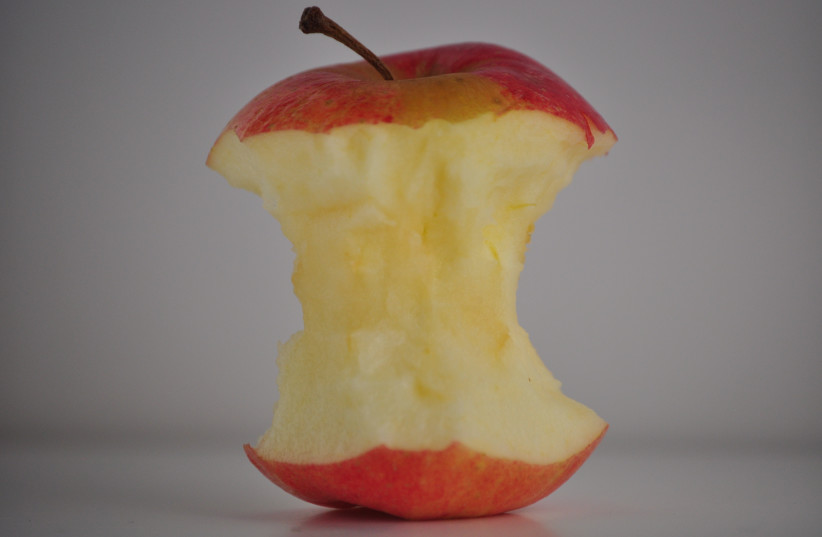Prof. Azzan Yadin-Israel’s latest work, Temptation Transformed: The Story of How the Forbidden Fruit Became an Apple, is a fascinating exploration that delves into the evolution of a concept taken for granted in popular discourse. The biblical account of Adam and Eve consuming the Forbidden Fruit leaves the specific identity of this fruit shrouded in the generic term pri, which simply means “fruit” in Hebrew. However, over time, this “fruit” has been widely perceived as an apple in pop culture. In this work, Yadin-Israel meticulously unravels the roots of this prevalent notion through an in-depth scholarly investigation.
Conventional wisdom says that the apple came to be understood as the Forbidden Fruit because the Latin word malum means “evil,” and its homonym malum (cognate with the English word “melon”) means “apple.” The popular theory goes that since Adam and Eve’s sinning by eating this fruit wrought evil upon the world, the very fruit in question must have been an apple, which is linguistically associated with “evil” – i.e., the apple because of the aforementioned homonym.
However, Yadin-Israel decisively debunks this theory by showing that it remains unsubstantiated when one studies early Latin commentators to the Bible. Through a masterful grasp of textual, literary, visual, and artistic references to the Fall of Man, the author eruditely navigates through proofs and counter-proofs, while conclusively discrediting the unsubstantiated Latin-based understanding.
The one attractive point of the malum theory is that the tradition associating the fruit with the apple is unknown in Hebrew, Aramaic, or Greek sources, thus lending credit to the notion that it must have sprung up from something related to Latin. However, the author rejects this point by noting that early Latin authors rarely referred to the Forbidden Fruit by the Latin term malum, instead using more generic words like fructus (“fruit”).
After rejecting this folk explanation, the author harnesses a wide array of sources in order to pinpoint exactly when and where the notion that the Forbidden Fruit was an apple came into existence. At that point, he shifts the focus to iconographic and artistic representations of the Fall of Man, tracing the emergence of the apple in such depictions to 12th-century France. Prior to this period, visual portrayals of the Forbidden Fruit simply did not feature apples.
Yadin-Israel intriguingly connects the rise of the apple theory in 12th-century France to the evolving semantic meaning of the French word pomme, transitioning from a generic term for “fruit” to specifically denoting an “apple.” Similar semantic shifts later occurred in Germanic languages like German and English, whereby apple/apfel transitioned from a generic word for “fruit” to a word that specifically means “apple.” The author makes the strong case that it was these internal semantic shifts within various European languages that actually led to the widespread misconception regarding the Forbidden Fruit’s identity. In other words, once the word for “fruit” came to specifically mean “apple,” people began to think that “forbidden fruit” actually just meant “forbidden apple.”
Before the apple theory gained traction and wide acceptance, there were earlier traditions that identify the fruit as something else. For example, various Jewish traditions (found in rabbinic sources, as well as in apocryphal literature) identify the Forbidden Fruit as a grape, fig, wheat, or citron. These traditions were also adopted by early Christian sources, who further conjectured that the fruit in question might have been a pomegranate (a word incidentally cognate with the French pomme mentioned above). Yadin-Israel meticulously documents these and other alternative theories as to the identity of the fruit in question, including less popular suggestions like the date and the banana.
This book is a testament to the value of rigorous scholarship, highlighting that nothing should be taken for granted, but rather all assumptions could and should be called into question. It also illustrates the idea that scholarship should not be confined to a single field but rather flourishes in a multi-disciplinary milieu. Yet, this book is written in easy English rather than dense academic jargon. It is also relatively short – I read it in one sitting. Indeed, this book presents a fascinating scholarly narrative that reads like a mystery novel, with the author acting like a detective uncovering the origins of the popular wisdom.
This book also includes beautiful pictures from various libraries that make up some of the iconographic evidence from which the author draws. Accompanying these stunning visuals are extensive endnotes and a bibliography that aid the reader in delving further into the topic. Moreover, the book goes beyond its pages, offering a companion website, https://treeofknowledgeart.com, where the author has collated hundreds of additional iconographic depictions of the Tree of Knowledge, enriching the reader’s exploration further.
In essence, Temptation Transformed invites readers on a journey through the annals of history, challenging preconceived notions, and revealing the intricate story behind the genesis of a pervasive cultural belief.
Reviewing The Jewish Bible: A Material History
DAVID STERN’S The Jewish Bible: A Material History serves as a scholarly exploration that diverges from “traditional” textual analyses by delving into the physical aspects and cultural significance of the Jewish Bible as a physical artifact. In doing so, the author departs from the exhaustive textual scrutiny that has dominated scholarly discourse on the Bible, and instead chooses to explore the material properties and cultural contexts of these revered objects.
The book’s first chapter meticulously dissects the earliest known specimens of Sifrei Torah (“Torah scrolls”), focusing on the materials on which scrolls were written (papyrus vs. parchment), the scripts in which the scrolls were written (ktav ashuri vs. ktav ivri), the scrolls’ physical dimensions, and the scribal layout of ancient scrolls that are still extant. While only touching on the stabilization and canonization of the Masoretic Text, the author’s primary focus remains on the Torah scrolls’ physical attributes.
In this chapter, Stern adeptly traces the evolution of the Hebrew Bibles (including those from the Dead Sea Scrolls) and sheds light on the number of “books” contained in each physical scroll. Moreover, he brings to the fore various scribal practices, drawing comparisons between those who penned the Dead Sea Scrolls and those who adhere to traditional rabbinic specifications. In doing so, he also highlights how these scribes may have mirrored or deviated from the norms of the larger scribal culture of the Mediterranean world.
Within this exploration, the opening chapter also ventures into the “para-material” aspects of the Torah scrolls. It particularly details their placement within synagogues, the rituals surrounding their removal and return to the Ark, and the ornamental elements that typically adorn the Torah’s case and mantle, as well as its assorted accompanying adornments (such as silver crowns, bells, and pointers).
The second chapter moves from scrolls to codices, discussing such famous biblical codices as the Aleppo Codex, the Leningrad Codex, Hilleli Codex, and various fragmentary pieces from the Cairo Genizah (like Codex Babylonicus). These codices differ from regular Torah scrolls by including vowelization marks, cantillation marks, and Masoretic glosses (while in Torah scrolls, only the consonants of the text are written). Stern elucidates the collaborative nature of creating these manuscripts involving multiple people like the sofer (“scribe”), who writes the consonantal text of the Torah; the nakdan (“punctuator”), who adds the vowelization and cantillation marks; and the masran (“Masorete scholar”), who adds the Masoretic notes and functioned much like a copy editor.
In doing so, the author unravels the intricacies of the aforementioned Masoretic notes and who exactly was involved in the Masoretic movement. This chapter also discusses in what ways the texts of biblical codices mirrored the way the text was laid out in biblical scrolls and how the Masoretic notes were incorporated in that layout. In addition, this chapter also talks about decorative “carpet pages” (so called because their design resembles the design typically woven into carpets) found in many codices, and speculates about their various purposes.
The final chapters of this book cover the evolution of printed Jewish Bibles, tracing their history from the mid-1400s to the present day. In those discussions, Stern unveils the shift from Masoretic glosses, once so central to biblical codices, to their near extinction in printed versions. An interesting thing about printed Jewish Bibles is that they were originally made to look like handwritten codices and did not initially try to look as more innovative or up to date than the older handwritten technology. Stern contrasts this with the situation in Yemen – where printing only arrived much later than in Europe – where the opposite phenomenon was found, as Jewish Yemenite scribes would often write manuscripts that were intended to look like printed editions.
The book is adorned with many beautiful photographs of the manuscripts (be they scrolls or codices) discussed, as well as examples of the sorts of items and features discussed in the book. These photographs generally come from items housed in various university or private libraries from around the world.
Because this work is written from an academic perspective, it often diverges from religious (Orthodox) Jewish sensibilities by using critical inquiry into religious assertions and their origins, occasionally clashing with traditional beliefs. For example, the author asks questions like why the rabbis would claim that certain rules about writing a Sefer Torah would be a halachah l’Moshe m’Sinai (“rule [transmitted] to Moses from Sinai”) instead of taking such rabbinic assertions at face value as reflecting a genuine oral tradition. The book’s body text contains references to primary sources (like the Bible and relevant rabbinic literature), while the endnotes contain more detailed references to secondary sources and scholarship, as well as more technical discussions.
One of the overarching themes throughout the book is the question of to what extent Jewish decorative practices for these items were influenced and/or mimicked outside (often Christian or Muslim) artistic norms versus to what extent Jews marked their religious items with a specific Jewishness.
In conclusion, David Stern’s work stands out as a significant scholarly contribution, breaking from conventional studies centered on textual content to delve deeply into the material properties and cultural contexts of Jewish biblical artifacts with the same scholarly rigor. Through meticulous research and insightful analysis, Stern illuminates the intricate physical aspects of Torah scrolls, codices, and printed Jewish Bibles. His extensive notes, comprehensive bibliography, and detailed index not only enhance the book’s scholarly credibility but also provide readers with a rich wellspring of sources for further exploration. This work cements itself as an invaluable resource, offering a fresh perspective on the tangible essence of these revered artifacts, reshaping our understanding of the Jewish Bible’s material journey across centuries.■
Rabbi Reuven Chaim Klein is the editor-in-chief of The Rachack Review, an online forum for book reviews on Jewish books. He is also an author, scholar, and freelance researcher. You can access more of his book reviews at: http://rachack.blogspot.com
- Temptation Transformed: The Story of How the Forbidden Fruit Became an Apple
- Azzan Yadin-Israel
- The University of Chicago Press, 2022
- 232 pages; $ 21.26
- The Jewish Bible: A Material History
- David Stern
- University of Washington Press, 2017
- 320 pages; $105

